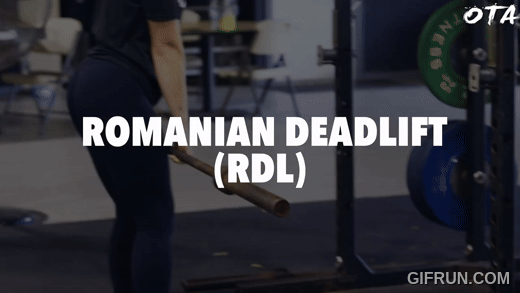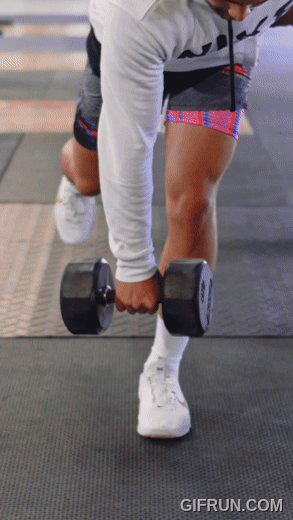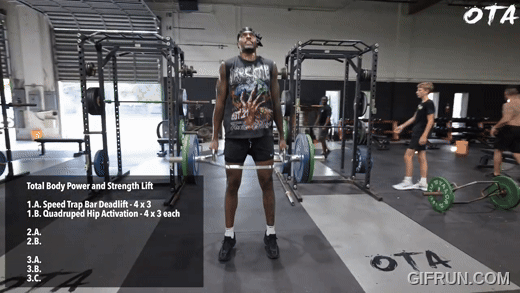The Romanian Deadlift: One of the Most Effective Exercises for Enhancing Athletic Performance

The Romanian Deadlift (RDL) is a staple in strength training programs for athletes across various sports. While it is often associated with powerlifting and bodybuilding, the RDL offers numerous benefits that directly translate to improved athletic performance. This exercise targets the posterior chain, consisting of the hamstrings, glutes, and lower back, which are essential for movements like sprinting, jumping, and decelerating. In this blog post, we will dive deep into the different ways the RDL enhances athletic performance, from posterior chain development to injury prevention, and why it should be included in any athlete’s training routine.
Posterior Chain Development
The Romanian Deadlift is perhaps one of the most effective exercises for developing the posterior chain. The posterior chain is a group of muscles along the back of the body, including the hamstrings, glutes, lower back, and upper back. These muscles are crucial for powerful and efficient movements such as sprinting, jumping, and even decelerating during athletic activities. When an athlete performs an RDL, they are focusing on hip extension, which is the primary movement used in all of these actions.
Whether using a barbell, dumbbell, kettlebell, or other variations of the RDL, this exercise strengthens the entire posterior chain, helping athletes develop explosive power and athleticism. In sports, the ability to extend the hips quickly and efficiently can mean the difference between a slow start and a fast one, or between a successful jump and a failed one. Stronger hamstrings and glutes provide better force production in the hips, which translates into better sprinting speed and more effective deceleration when stopping. The RDL also engages the lower back and stabilizing muscles in the upper back, improving overall posture and structural integrity, which is essential for both injury prevention and optimal performance in athletic movements.
Unilateral Strength and Stability

Another major benefit of incorporating RDL variations into an athlete’s training is the improvement of unilateral strength and stability. Many sports require athletes to perform movements that are uneven or one-sided, such as cutting, pivoting, or shifting weight from one leg to another. Unilateral strength helps improve an athlete’s ability to stabilize and generate power on one leg at a time. Variations of the Romanian Deadlift, such as the Single-Leg RDL and Suitcase RDL, are particularly effective at enhancing balance and stability in each leg individually.
In the Single-Leg RDL, the athlete balances on one leg while performing the hip-hinge motion, engaging the hamstrings, glutes, and lower back of the working leg. This unilateral exercise helps improve proprioception (awareness of body position) and strengthens the stabilizing muscles around the ankle, knee, and hip. Additionally, the Single-Leg RDL helps to address muscular imbalances by targeting each leg independently, ensuring that one leg does not compensate for the other.
The Suitcase RDL, performed while holding a weight in one hand, also targets unilateral stability. In this variation, the athlete works on resisting lateral flexion and maintaining proper posture as they hinge forward. This improves core stability and challenges the body to engage its stabilizing muscles more effectively. By strengthening each leg individually and improving unilateral stability, athletes enhance their ability to perform dynamic movements such as side cuts, lateral sprints, and jumps, which are essential in most team sports and track and field.
Power and Explosiveness

Power and explosiveness are two essential qualities that many athletes strive to improve in order to enhance their on-field performance. The Romanian Deadlift can be modified to specifically target these attributes by incorporating Speed RDLs or Explosive RDLs into a training regimen. These variations focus on developing the rate of force development (RFD), which is the ability to generate maximum force in the shortest amount of time.
When performing Explosive RDLs, the emphasis is on a fast, powerful hip extension. The goal is to perform the exercise with as much speed and force as possible, engaging the muscles of the posterior chain quickly and efficiently. This type of training is particularly beneficial for athletes in high-intensity sports such as football, basketball, and track and field, where rapid acceleration, quick direction changes, and explosive jumping abilities are critical.
By incorporating speed and explosive variations of the RDL, athletes improve their ability to accelerate quickly, jump higher, and perform other explosive movements with greater force. The ability to develop power and explosiveness through the posterior chain enhances performance in many areas, including sprints, vertical jumps, and powerful changes of direction during play.
Injury Prevention
In addition to enhancing athletic performance, the Romanian Deadlift plays a significant role in injury prevention. One of the most common injuries in sports is hamstring strains, which can occur when the hamstrings are not properly conditioned to handle the forces exerted during running, sprinting, or sudden changes in direction. The RDL specifically targets the hamstrings and helps to improve their strength, flexibility, and eccentric control, which is essential for preventing strains and tears.
Paused RDLs and variations with resistance bands, such as the Hip Hinge with Bands, are particularly effective at improving eccentric control. In these variations, the athlete pauses at the bottom of the movement or uses bands to provide resistance during the eccentric (lowering) phase of the exercise. This helps develop strength in the hamstrings and glutes during deceleration, which is crucial when an athlete is coming to a sudden stop or changing direction quickly.
By reinforcing proper mechanics, controlling the lowering phase of the movement, and improving muscle endurance, the RDL can reduce the risk of injury and improve overall muscle resilience. Core stability is also a critical component of injury prevention, and by engaging the core during the RDL, athletes can improve their posture, reduce strain on the lower back, and prevent overuse injuries from improper technique.
Mobility and Flexibility
The Romanian Deadlift, especially when performed with kettlebells or dumbbells, can also improve mobility and flexibility, which is key to performing explosive movements more effectively and with less risk of injury. The RDL requires a good range of motion at the hip joint, and exercises like the Kettlebell RDL allow for deeper hip flexion while maintaining proper form. This increased range of motion helps to develop hip mobility and flexibility, which is beneficial for both performance and injury prevention.
Athletes with good hip mobility can generate more force in their hips, improving their ability to produce powerful sprinting strides, jumps, and cuts. Furthermore, developing flexibility through RDL variations can improve posture and movement efficiency, which is crucial for athletes to maintain peak performance throughout the season. The dynamic movement of the RDL also helps to stretch the hamstrings and glutes, improving overall flexibility and reducing tightness, which can often lead to muscle strain or discomfort during physical activity.
Conclusion
The Romanian Deadlift is one of the most effective exercises for enhancing athletic performance due to its ability to target the posterior chain, improve unilateral strength, develop power and explosiveness, prevent injuries, and increase mobility and flexibility. Whether performed with a barbell, dumbbell, kettlebell, or in its various variations, the RDL is an essential movement for any athlete looking to enhance strength, improve on-field performance, and reduce the risk of injury. By incorporating this versatile exercise into their training routine, athletes can experience significant improvements in sprinting, jumping, decelerating, and other dynamic movements required in sports!

